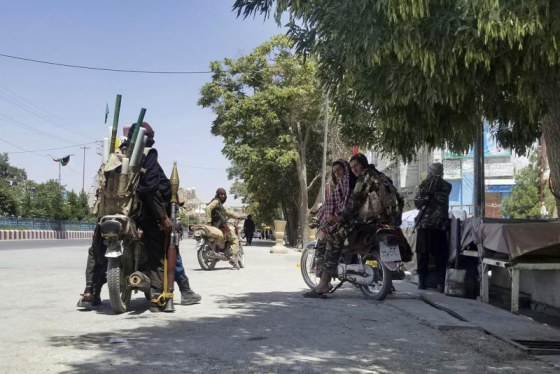KABUL, Afghanistan (AP) — The Taliban captured a strategic provincial capital near Kabul and broke through defensive lines in Afghanistan’s third-largest city Thursday, further squeezing the country’s embattled government just weeks before the end of the American military mission there.
Seizing Ghazni cuts off a crucial highway linking the Afghan capital with the country’s southern provinces, which similarly find themselves under assault as part of an insurgent push some 20 years after U.S. and NATO troops invaded and ousted the Taliban government. Meanwhile, the assault on the city of Herat, still raging Thursday night, could put nearly all of western Afghanistan under Taliban control just a day after the militants completed their capture of the country’s northeast.
While Kabul itself isn’t directly under threat yet, the loss of Ghazni and the battles elsewhere further tighten the grip of a resurgent Taliban estimated to now hold some two-thirds of the nation. Thousands of people have fled their homes amid fears the Taliban will again impose a brutal, repressive government, all but eliminating women’s rights and conducting public amputations, stonings and executions. Peace talks in Qatar remain stalled, though diplomats met throughout the day.
The latest U.S. military intelligence assessment suggests Kabul could come under insurgent pressure within 30 days and that, if current trends hold, the Taliban could gain full control of the country within a few months. The Afghan government may eventually be forced to pull back to defend the capital and just a few other cities in the coming days if the Taliban keeps up its momentum.
The onslaught represents a stunning collapse of Afghan forces and renews questions about where the over $830 billion spent by the U.S. Defense Department on fighting, training those troops, and reconstruction efforts went — especially as Taliban fighters ride on American-made Humvees and pickup trucks with M-16s slung across their shoulders.
Afghan security forces and the government have not responded to repeated questions from journalists over the days of fighting, instead issuing video communiques that downplay the Taliban advance.
On Thursday, the militants raised their white flags imprinted with an Islamic proclamation of faith over the city of Ghazni, just 130 kilometers (80 miles) southwest of Kabul.
Militants crowded onto one seized Humvee and drove down a main road, with the golden dome of a mosque near the governor’s office visible behind them, yelling: “God is great!” The insurgents, cradling their rifles, later gathered at one roundabout for an impromptu speech by a commander. One militant carried a rocket-propelled grenade launcher.
Ghazni provincial council member Amanullah Kamrani alleged that the provincial governor and police chief made a deal with the Taliban to flee after surrendering. Taliban video and photos purported to show the governor’s convoy freely passing by Taliban fighters as part of the deal.
Later Thursday, Afghan Interior Ministry spokesman Mirwais Stanekzai said the governor and his deputies had been arrested over that alleged deal. The officials could not be immediately reached for comment.
Stanekzai also acknowledged in a video message that parts of Ghanzi had fallen, though he insisted government security forces “do exist” in the city.
The loss of Ghazni — which sits along the Kabul-Kandahar Highway — could complicate resupply and movement for government forces, as well as squeeze the capital from the south.
Already, the Taliban’s weeklong blitz has seen the militants seize nine other provincial capitals around the country. Many are in the country’s northeast corner, pressuring Kabul from that direction as well.
Several more are under pressure. Herat, Afghanistan’s third-largest city and the capital of a province with the same name, has been targeted in militant attacks for days. On Thursday afternoon, the insurgents broke through the city’s defensive lines.
Witnesses described the Taliban as moving through the streets, battling government forces. The fighting closed highways, and Herat’s airport suspended flights amid the chaos.
Video posted by the Taliban shows insurgents capturing the provincial police headquarters. A person close to Ismail Khan, one of the warlords fighting the Taliban, said his forces were under siege in the governor’s office and the intelligence department. The sound of heavy gunfire rang out near the governor’s office.
The person spoke on condition of anonymity because he was not allowed to speak to the media.
In southern Afghanistan, the Taliban’s heartland, heavy fighting continued in Lashkar Gah, where surrounded government forces hoped to hold onto the capital of Helmand province.
On Wednesday, a suicide car bombing marked the latest wave of violence to target the capital’s regional police headquarters. By Thursday, the Taliban had taken the building, with some police officers surrendering to the militants and others retreating to the nearby governor’s office that’s still held by government forces, said Nasima Niazi, a lawmaker from Helmand.
In neighboring Kandahar, the Taliban attacked a prison in the capital city and freed inmates inside Wednesday night, officials said. On Thursday, Kandahar provincial governor spokesman Bahir Ahmadi acknowledged that the Taliban had entered the capital, also called Kandahar, but said Afghan forces were fighting to push them back.
Niazi criticized ongoing airstrikes targeting the area, saying civilians likely had been wounded and killed.
“The Taliban used civilian houses to protect themselves, and the government, without paying any attention to civilians, carried out airstrikes,” she said.
With the Afghan air power limited and in disarray, the U.S. Air Force is believed to be carrying out strikes. Aviation tracking data suggested U.S. Air Force B-52 bombers, F-15 fighter jets, drones and other aircraft were involved in the fighting across the country, according to Australia-based security firm The Cavell Group.
U.S. Air Force Maj. Nicole Ferrara, a Central Command spokeswoman, acknowledged that American forces “have conducted several airstrikes in defense of our Afghan partners in recent days.” However, she declined to offer any details on the attacks or to discuss the Afghan complaints of civilian casualties.
Even as diplomats met in Doha, Qatar on Thursday, the success of the Taliban offensive called into question whether they would ever rejoin long-stalled peace talks aimed at moving Afghanistan toward an administration that includes members of the current Afghan government and the Taliban. Instead, the Taliban could come to power by force — or the country could splinter into factional fighting like it did after the Soviet withdrawal in 1989.
The government’s High Council for National Reconciliation called for peace talks to resume, saying it had submitted a plan to Qatar, without elaborating.
Copyright 2021 The Associated Press. All Rights Reserved. This material may not be published, broadcast, rewritten, or redistributed. Photo: AP





















